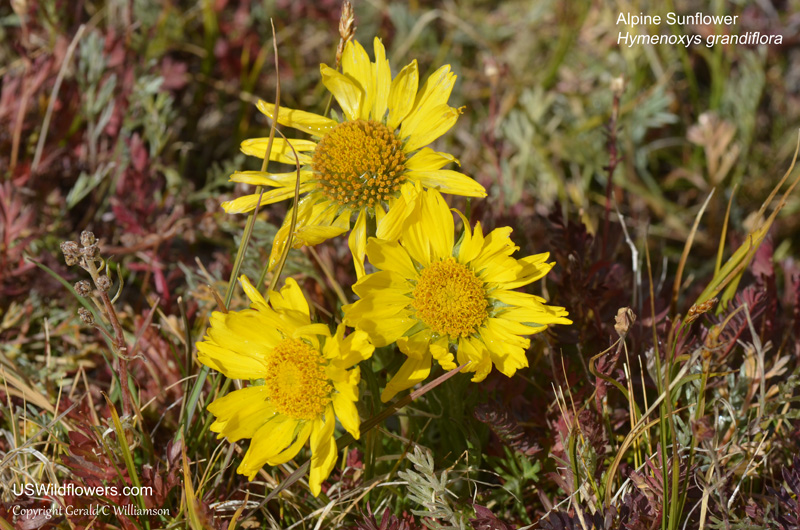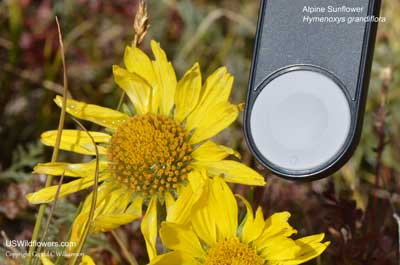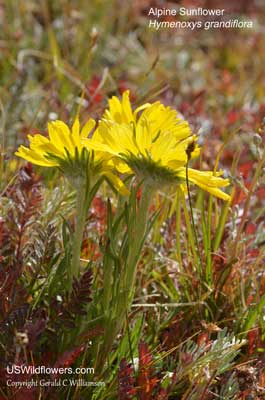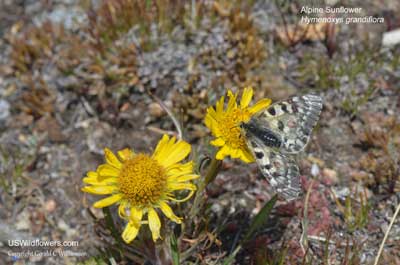Alpine Sunflower, Four-nerved Daisy, Graylocks Rubberweed, Old-man-of-the-mountain - Hymenoxys grandiflora
|
Hymenoxys grandiflora - Alpine Sunflower, Four-nerved Daisy, Graylocks Rubberweed, Old-man-of-the-mountain. Hymenoxys is a genus of about 25 species native to western North America, Central America, and South America. About 17 are found in North America, all in the western part of the United States, with one (H. richardsonii) extending its range into Canada.
Hymenoxys grandiflora was first collected by explorer and politician John Fremont (once a presidential candidate) in 1842, and it was given the name Actinella grandiflora in 1845 by botanists John Torrey and Asa Gray. In 1898 it was renamed to Rydbergia grandiflora by Edward Greene. It apparently got a lot of attention in 1980, when it was placed in Hymenoxys and then in Tetraneuris. Some authorities continue to list it as Tetraneuris grandiflora (as it was once listed in Flora of North America), and I've found one reasonably scientific treatment listing it as Rydbergia grandiflora, but ITIS and Flora of North America call it Hymenoxys grandiflora (probably based on early 21st century papers by Mark W. Biemer), so that is the name I'll use. The Rydbergia association lives on in that this plant is within the Rydbergia subgenus of Hymenoxys.
Whatever you call it, this bright flower makes a cheery appearance above the treeline in alpine meadows of five Rocky Mountain states.
Found in:
CO, ID, MT, UT, WY
Leave comments on Hymenoxys grandiflora at this link. | 
Distribution of Hymenoxys grandiflora in the United States and Canada:

Map courtesy of The Biota of North America Program.
Map color key
Search Our Database: Enter any portion of the Scientific, Common Name, or both.
Do a general Google search of the entire site:
#ad
 Follow USWildflowers on Twitter
| | Site: Rocky Mountain National Park, Grand County, CO Date: 2016-August-26 | Photographer: Gerald C Williamson
Nikon D7000
Tamron SP 90MM f/2.8 AF Macro | | Hymenoxys grandiflora is a member of the Composite family, aka the Aster family - Asteraceae. Many also call it the Sunflower family, and this plant certainly suits that name with its bright yellow appearance in high alpine meadows where colors are frequently more muted. In spite of the name Alpine Sunflower, this plant is different from "true sunflowers" (Helianthus) and some other members of the family in that the flower of Helianthus will turn toward the sun, following it from east to west as the sun rises and sets. Hymenoxys grandiflora continues to face east, even as the sun marches across the sky. There is speculation that this may be an adaptation that protects it from the violent afternoon thunderstorms which typically arrive from the west in the Rocky Mountains. | | 
| | Site: Rocky Mountain National Park, Grand County, CO Date: 2016-August-26 | Photographer: Gerald C Williamson
Nikon D7000 | | "Grandiflora" means large-flowered. Not only does this plant have the largest flower of any in the Hymenoxys genus, it is one of the largest in its alpine environment, frequently more than three inches across (the white button on my camera remote shutter release is almost exactly 1 inch across. Each of the up to 15-44 three-toothed, yellow ray florets can be more than an inch long. The central disc is made up of from 150 to over 400 yellow florets, and is an inch or more across. | | Click on the photo for a larger image

| | Site: Rocky Mountain National Park, Grand County, CO Date: 2016-August-26 | Photographer: Gerald C Williamson
Nikon D7000 | | The Old-man-of-the-mountain common name comes from its wooly stem and leaves, sometimes much hairier than can be seen here. The plant is usually 3 or 4 inches tall, but may be as tall as 12 inches. A single plant will have from 1 to 10 stems, each terminating with (usually) a single flower. There are both basal and stem leaves, which may be unlobed or have narrow lobes. | | Click on the photo for a larger image

| | Site: Rocky Mountain National Park, Grand County, CO Date: 2016-August-26 | Photographer: Gerald C Williamson
Nikon D7000 | | I think this is a Rocky Mountain Parnassian (Parnassius phoebus smintheus) nectaring on the Old-man-of-the-mountain. | | Click on the photo for a larger image

|
References used for identification and information:
|
|
| |
| #ad
|
|






